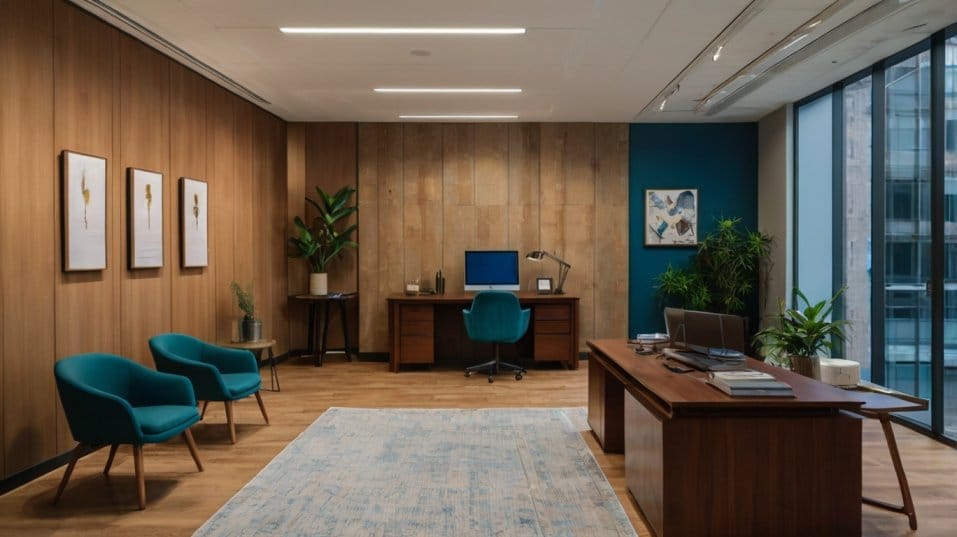Why Natural Colors in Your Office Affect Your Mood
Learn how natural colors like green and blue boost mood, reduce stress, and enhance productivity through mindful office design.

Have you ever walked into a space and instantly felt more focused or at ease without knowing why? The colors around you could be shaping your mood, energy, and productivity in ways you don’t even realize.
Science reveals that natural hues—drawn from elements like sky, earth, and foliage—have a profound effect on stress levels and cognitive performance.
By understanding how these colors influence your mind, you can create a workspace that fosters mindfulness, efficiency, and overall well-being.
The Science of Color Psychology
Colors evoke subconscious associations and physiological responses, influencing everything from heart rate to stress levels.
Warmer tones, like red and orange, activate alertness and energy, while cooler shades, like blue and green, instill calm and concentration.
The interplay between these colors can shape an environment that supports both high-focus tasks and moments of relaxation.
Different wavelengths of light stimulate various parts of the brain. Blue light enhances cognitive function and attentiveness, making it ideal for focused work.
Green light has been shown to reduce fatigue and increase reading efficiency. Even the absence of strong colors—neutral tones like beige and off-white—can impact perception, helping spaces feel more open and inviting.

How Natural Colors Influence Productivity and Mindfulness
The colors in your environment do more than create visual appeal—they actively shape your mental state and efficiency. Each natural hue carries unique psychological benefits, influencing everything from stress levels to creativity.
Green: The Restoration and Growth Booster
Often associated with nature, green symbolizes renewal, balance, and tranquility. Exposure to green tones has been linked to lower cortisol levels, which helps mitigate stress and prevent burnout.
Offices with natural greenery also promote eye relaxation, reducing digital strain. Incorporating green can be as simple as adding potted plants, moss walls, or subtle desk accessories in varying shades of green.
Blue: The Mind-Clearing Powerhouse
Blue fosters a sense of stability and clear thinking. Studies suggest that employees working in blue-dominant environments tend to be more productive and make fewer errors.
Lighter blues can create a sense of openness and relaxation, while deeper blues enhance focus and concentration. From accent walls to blue-hued furniture, this color serves as an excellent tool for high-performance workplaces.
Earthy Tones: Stability and Warmth
Natural shades like beige, taupe, and brown create a grounding effect, reducing anxiety and enhancing a sense of comfort.
These tones are associated with reliability and security, making them a great choice for executive offices and collaborative spaces.
Textured materials—like wooden desks, woven baskets, and stone accessories—add a tactile connection to nature that enhances the calming effects of earthy colors.
Yellow: The Energy and Innovation Catalyst
Bright and uplifting, yellow stimulates creativity and motivation. It’s often used in brainstorming rooms and design studios where out-of-the-box thinking is encouraged.
However, overuse can lead to overstimulation, increasing stress and irritation. A balanced approach—such as a yellow-accented chair, a vibrant rug, or strategically placed artwork—introduces energy without overwhelming the senses.
White and Off-White: Clarity Without Sterility
White reflects light and creates an illusion of spaciousness, making it ideal for small offices. However, overly stark white environments can feel cold and impersonal.
A blend of off-white tones with natural elements—such as warm wood furniture, soft textiles, or greenery—can enhance the feeling of cleanliness while maintaining a welcoming atmosphere.
The Role of Red and Orange
Although less commonly used in workspaces, red and orange have powerful psychological effects. Red stimulates urgency and excitement, making it effective in high-energy areas like sales floors.
Orange blends warmth and enthusiasm, often appearing in creative agencies or social spaces where collaboration is key. Since both colors are intense, they work best as accent tones rather than dominant hues.
Integrating Natural Colors Into Your Workspace
Bringing nature-inspired colors into your office doesn’t require a complete redesign. Simple, intentional changes can transform your space into a more calming and productive environment.
Transform Walls with Subtle, Soothing Hues
Painting office walls in soft greens, blues, or earthy neutrals creates a visually calming space. If repainting isn’t an option, framed prints, murals, or wall decals in these tones can achieve a similar effect.
Wall-mounted plant installations also offer a unique way to incorporate color while enhancing air quality.
Incorporate Wood and Organic Textures
Natural wood furniture, bamboo accents, or linen textiles add warmth and an organic feel. Even small additions—like a wooden desk organizer or a woven rug—can soften a workspace and create a more relaxing environment.
Sustainable materials not only improve aesthetics but also align with wellness-focused office designs.
Bring in Plants for a Refreshing Touch
Beyond their visual appeal, plants improve air quality and contribute to a sense of well-being. Low-maintenance options like snake plants, pothos, or succulents require minimal effort while providing maximum impact.
Research indicates that offices with plants experience lower levels of fatigue and increased employee satisfaction.
Optimize Lighting for a Natural Glow
Lighting plays a crucial role in how colors are perceived. Maximize natural light where possible by positioning desks near windows.
If natural light is limited, use warm LED bulbs or daylight-mimicking lamps to enhance the effects of your color choices. Light-filtering curtains can soften harsh brightness while still allowing in beneficial natural light.
Personalize Your Workspace With Color Accents
Small, intentional color additions can make a significant difference. Consider colorful desk organizers, throw pillows, or even a patterned rug that aligns with your chosen palette.
Personal touches help create a sense of ownership and comfort, boosting both mood and motivation.
Final Thoughts
The colors surrounding you aren’t just decorative—they influence how you think, feel, and work. By integrating natural hues into your office, you create a workspace that promotes focus, balance, and well-being.
Start small—add a plant, switch up your desk accessories, or introduce a calming wall color—and notice how even subtle changes can enhance your daily workflow.
If your office environment feels uninspiring, a mindful approach to color might be the key to unlocking productivity and creativity.




